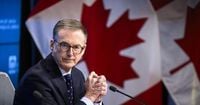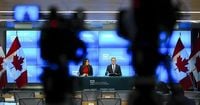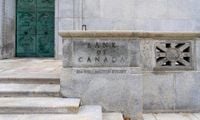The Bank of Canada (BoC) is facing a pivotal decision on interest rates as it navigates a turbulent economic landscape marked by shifting global trade conditions and political uncertainties. With inflation rising and the economic outlook increasingly muddled, the central bank must choose between implementing a quarter-point rate cut or pausing after a series of reductions.
As reported on April 15, 2025, the BoC has been on a path of consecutive rate cuts, having reduced its benchmark rate seven times in a row. The current rate stands at 2.75 percent, and a further cut would bring it down to 2.5 percent. Governor Tiff Macklem indicated last month that traditional economic forecasting methods may no longer suffice due to the erratic nature of U.S. President Donald Trump’s tariff policies. He noted, “We need to set policy that minimizes the risk. That means being less forward-looking than normal until the situation is clearer. And it may mean acting quickly when things crystallize.”
The uncertainty surrounding U.S. trade policies has left Canadian economists grappling with the implications of tariffs that have been both imposed and subsequently adjusted. In March, Trump announced sweeping tariffs on all Canadian imports, only to later exempt certain goods that comply with the continental free trade agreement. However, levies on key sectors such as automobiles, steel, and aluminum remain firmly in place.
Moreover, the U.S. administration has recently escalated tariffs on Chinese goods to an astonishing 145 percent, further complicating the economic situation. David Dodge, a former governor of the Bank of Canada, expressed concern over the dual pressures of slowing economic growth and rising inflation, stating, “The problem is they’ve got a slowing economy in the United States, they have a slowing economy in the world, they have a slowing domestic economy.”
Current economic indicators paint a mixed picture. The inflation rate surged to 2.6 percent in February, up from 1.9 percent in January, marking the first time in seven months that it breached the BoC's target of 2 percent. Analysts attribute part of this spike to the expiration of a temporary GST and HST tax holiday. The upcoming March inflation figures, set to be released on April 16, 2025, are expected to add further complexity to the BoC's decision-making process.
As the central bank weighs its options, market data from interest rate swaps reveals a split in expectations, with a 60 percent likelihood of a pause and a 40 percent chance of a rate cut. This uncertainty underscores the delicate balancing act the BoC must perform, particularly as it contemplates the impact of external economic shocks.
Despite the inflationary pressures, some indicators suggest that the Canadian economy is stabilizing. For instance, GDP growth has exceeded expectations, indicating a solid start to 2025. However, job figures have weakened, and sentiment surveys conducted by the Bank of Canada show growing anxiety among businesses and consumers regarding the potential fallout from a trade war with the U.S.
Toronto-Dominion Bank strategists, led by Andrew Kelvin, noted that the BoC has been focusing on “backward-looking hard data,” while forward-looking indicators remain weak. They remarked, “Normally that would be a tricky balancing act for a forecaster, but the Bank was so kind as to tell us that they were going to focus on the backward-looking hard data. The 90-day global tariff ramp down really just helps cement the pause.”
Avery Shenfeld, chief economist at Canadian Imperial Bank of Commerce, anticipates that the BoC may opt for a rate cut, citing multiple downside risks that could impact economic stability. Shenfeld suggested that the central bank could justify delaying a decision until June, as the economic fallout from waiting would likely be minimal. However, he also pointed out that “the advantage of moving now is that the accompanying Monetary Policy Report can’t avoid talking about the downside risks to growth.”
In light of the recent appreciation of the Canadian dollar, which rose to over 72 U.S. cents from under 70 cents in March, the BoC might find some relief. This rise in currency value makes imports cheaper, potentially alleviating some inflationary pressures stemming from tariffs imposed by Ottawa.
The central bank is set to release its quarterly Monetary Policy Report alongside its rate decision, a document that typically includes forecasts for growth and inflation. However, Macklem hinted that the Bank may choose to forgo issuing a central scenario this time, a strategy last employed during the early months of the COVID-19 pandemic when uncertainty was at its peak.
As the Bank of Canada prepares to make its decision, the economic landscape remains fraught with challenges. The interplay between rising inflation, global trade disruptions, and domestic economic indicators will undoubtedly shape the central bank's approach in the coming months. Observers will be watching closely to see whether the BoC opts for a rate cut or maintains its current stance, as both choices carry significant implications for the Canadian economy.
In summary, the BoC's decision this week is not just a reflection of current economic conditions but also a response to an increasingly unpredictable global environment. As tensions around trade continue to evolve, the central bank's actions will be critical in steering the Canadian economy through these turbulent waters.






